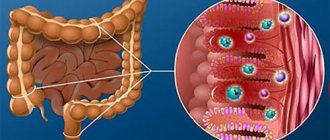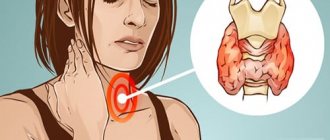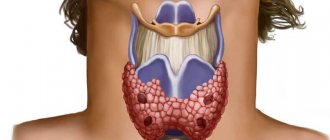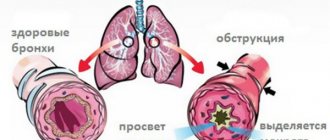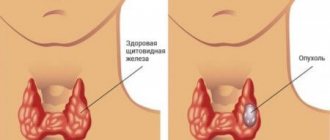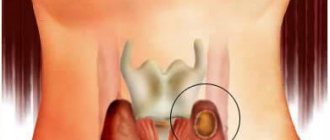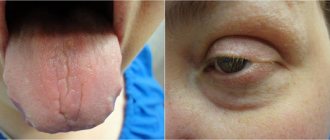Thyroid diseases are common today.
There are many reasons that provoke their development. But all pathologies are united by three main disorders of endocrine functions - hypothyroidism, hyperthyroidism and clinical euthyroidism of the thyroid gland.
Euthyroidism is a condition of an endocrine organ in which thyroid hormones and thyroid-stimulating hormone show normal values. The clinical concept of euthyroidism is used in laboratory practice.
Euthyroidism of the thyroid gland: what is it?
With euthyroidism, the concentration of triiodothyronine, as well as thyroxine, is within normal limits. Thyroid-stimulating hormone produced by the pituitary gland (thyrotropin) is also maintained at optimal levels. Despite this, the glandular tissue of the thyroid gland, namely its anatomical structure, begins to change. There is an increase in its volume, nodular connections are formed, and there is a risk of goiter formation.
Euthyroidism of the thyroid gland negatively affects the functioning of the body as a whole. It is difficult to identify the disease, since it is not always possible to determine the pathological process by the levels of the hormones T3, T4 and TSH. That's why it's so important to know the main symptoms. This will allow you to see a doctor in time and start treatment.
Causes
Clinical hormonal euthyroidism most often occurs when exposed to the following factors:
- long-term iodine deficiency in the body;
- hormonal imbalances;
- increased background radiation;
- ecologically unfavorable area;
- work related to chemically aggressive substances;
- severe stress;
- autoimmune diseases (rheumatism, lupus erythematosus, etc.);
- physical overload;
- uncontrolled use of hormonal and antibacterial drugs;
- hereditary predisposition.
Risk group
Endocrinologists include factors contributing to the development of euthyroidism:
- Genetic predisposition. If someone in your family has a thyroid disease, you need to pay maximum attention to the functioning of the endocrine system.
- The presence of diseases accompanied by the presence of an inflammatory process in the thyroid gland.
- Prolonged exposure to direct sunlight.
- Constantly being under conditions of severe stress.
- Infectious diseases of the nasopharynx.
- Living in unfavorable environmental conditions.
- Abuse of hormonal and antibacterial drugs.
- Pregnancy. Euthyroidism during pregnancy develops due to a lack of minerals and nutrients, iodine, therefore, at the planning stage of conception, it is recommended to drink iodine-containing medications.
Classification
With non-toxic goiter, the thyroid tissue increases in size, resulting in the formation of one or more nodes.
Types of nodular goiter with damage to the gland:
- Endemic. It is formed due to iodine deficiency in the body.
- Nodular goiter with euthyroidism. The thyroid gland increases in size, but there are no nodes in it.
- Nodular goiter of the 1st degree. In such a goiter, 1 node is formed.
- 2 degrees. In this case, several nodes are formed in the thyroid gland at once.
- Nodular goiter with multiple nodes intertwined with each other.
Source: https://travmatolog.net/eutireoz-shhitovidnoj-zhelezy/
What is euthyroid goiter?
Diffuse euthyroid goiter is a diffuse enlargement of the thyroid gland of non-toxic origin visible to the eye or accessible to palpation. The enlargement of the thyroid gland in this case is of an adaptive nature; the function does not change, as does the amount of hormones in the peripheral blood.
Nodular goiter is characterized by limited proliferation of thyroid tissue, resulting in the formation of single or multiple nodes on the surface of the gland.
The reason for contacting a specialist in this case is a visible cosmetic defect in the neck area, and in rare cases, a feeling of heaviness and squeezing. The diagnosis is made based on physical examination and laboratory tests.
Euthyroidism of the thyroid gland - what is it, causes, symptoms, treatment, danger of the condition
The condition of the thyroid gland, in which we can speak of a diagnosis of euthyroidism, is given to people with minor dysfunctions of the thyroid gland.
The thyroid gland is an organ that many people deprive of their attention, but sometimes even its normal functioning can only be a mask under which the disease is skillfully hidden.
In this article we will look at what this condition is, what symptoms and treatment methods are effective.
What is euthyroidism?
Euthyroidism is a condition of the thyroid gland that is quite difficult to recognize on your own. With the disease, thyroid hormones are at normal levels, and nothing bothers the person, but an ultrasound examination reveals pathological changes.
The thyroid gland is the most important of the endocrine organs, and in addition, it is one of the most dangerous glands in the body.
The main danger from its work is that often the gland itself can mask its problems and diseases for a long time.
In some cases, only an experienced doctor is able to recognize the primary signs of gland disease, especially when it comes to a state of euthyroidism.
The patient does not complain about his state of health; a test for thyroid hormones shows normal values, but an ultrasound shows pathological changes in the thyroid gland.
Thus, against the background of euthyroidism, the development of euthyroid pathology syndrome, autoimmune thyroiditis, goiter and even thyroid cancer is possible. Vivid symptoms of these diseases will appear only when the organ is no longer able to produce the required amount of hormones.
Causes
There are not many reasons for the occurrence of euthyroidism of the thyroid gland, but all of them are a reason to conduct additional examinations and pay a little more attention to the thyroid gland than usual.
- The most common problem is iodine deficiency. Against this background, proliferation of thyroid tissue is very often observed, which is fraught with the development of quite unpleasant diseases.
- Genetic predisposition plays an important role. Therefore, if one of your relatives suffers from problems with the endocrine system, you need to monitor your thyroid gland with special care.
- Recently, euthyroidism has been diagnosed more often due to the fact that people are under constant stress.
- Various infectious diseases of the nasopharynx should be treated with special care: sinusitis, sinusitis, tonsillitis, tonsillitis. Sometimes euthyroidism and nodular goiter can develop against their background.
- It is also not recommended to abuse various antibiotics and hormonal drugs. Their excessive consumption may well lead to disruption of the endocrine system.
Also, the causes of euthyroidism usually include:
- Heredity;
- Bad ecology;
- Inflammatory processes in the thyroid gland.
Symptoms of euthyroidism
People are often surprised by the diagnosis of euthyroidism. Only ultrasound and some additional studies show that they have this disease. However, there are a number of symptoms that are an indicator that there is something wrong with the thyroid gland, even if the hormone test is normal.
Symptoms:
- Irritability, frequent nervousness without significant reasons.
- Excessive fatigue.
- A visual examination revealed a slight swelling in the neck area.
- When swallowing, a feeling of a lump is typical; sometimes it can be very difficult to swallow.
- upon palpation, the doctor may detect small nodular formations in the neck area; They are mostly painless, and only occasionally do patients complain of discomfort, for example, when the neck is compressed by a clothing collar.
Degrees:
- 1st degree. At this stage of development, the thyroid gland is not enlarged and there is no way to palpate it;
- 2nd degree. The gland can be palpated;
- 3rd degree. The outline of the gland can be seen when swallowing;
- 4th degree. The goiter is localized over a large area of the neck;
- 5th degree. The gland is so enlarged that it begins to put pressure on the surrounding tissues and organs.
Danger of condition
Euthyroidism is a relatively safe disease, but only as long as normal levels of hormones in the blood are maintained.
Its rapid progression leads to the appearance of nodular goiter, requiring immediate treatment.
If you let the problem take its course, you can face serious consequences - the development of a malignant neoplasm, compression of the trachea. Then the thyroid gland is removed.
Diagnostics
Diagnosis of euthyroidism of the thyroid gland includes:
- Diffuse euthyroid goiter is easy to diagnose during examination and by palpation.
- To clarify the size and structural structure of the gland (type of damage), ultrasound diagnostics is performed.
- If there are nodular changes in the tissues of the organ, fine-needle biopsy and scintigraphy are indicated.
- Immunogram analysis, which determines the presence of lymphocytes and antibodies to thyroglobulin and gland cells;
- Determination of the level of TSH, T3, T4 and thyroglobulin in the blood.
Depending on the test results obtained, initially the pathology may not require treatment, only active observation and preventive measures. This will be shown in cases where the gland does not enlarge, the patient’s condition is quite stable, and the hormonal levels do not deviate from the norm.
Treatment of euthyroidism of the thyroid gland
In most cases, what is needed is not treatment, but regular observation by an endocrinologist and periodic monitoring of the functional state of the thyroid gland.
Diseases accompanied by hypothyroidism
Hypothyroidism is a symptom complex that develops with a decrease in thyroid hormones. The functioning of the thyroid gland is controlled by the central nervous system organs - the pituitary gland and hypothalamus. Based on the level of damage, they distinguish:
- Primary hypothyroidism - a disorder that occurs directly in the thyroid gland;
- Secondary hypothyroidism - the disorder occurs in the pituitary gland;
- Tertiary hypothyroidism is a disorder in the hypothalamus.
In addition, hypothyroidism can be congenital or acquired. The diagnosis of congenital hypothyroidism is registered with a frequency of 1:4000; girls are more often affected.
In 90% of patients, hypothyroidism is primary. The most common cause of hypothyroidism is underdevelopment of the thyroid gland, which causes less thyroid hormones to be produced . The baby suffers from this while still in the mother’s belly.
The first signs of congenital hypothyroidism can manifest at different ages. With severe hypoplasia and even aplasia of the gland, the symptoms of the disease appear literally from the first days of life. Mild hypoplasia of the gland can cause signs of hypothyroidism to appear in a child between two and six years of age.
Hypothyroidism in newborns
Babies with congenital hypothyroidism are born with heavy weight, facial features are rough, and the tongue is sometimes so enlarged that it does not shrink in the mouth. The baby's skin is dry and cold to the touch, and swelling on the body can be noticed. Drowsiness, passivity of the child, sluggish breastfeeding, bloating, constipation, episodes of apnea, prolonged jaundice are noted. If you do not increase the level of thyroid hormones in time, it means that by the age of six months the baby will have the classic picture of hypothyroidism:
- Delayed psychophysical development (cretinism);
- Functional disorders of internal organs;
- Trophic changes in the skin.
Unfortunately, at this stage a serious and almost irreversible disruption of mental development occurs.
Note! Given such severe consequences of the disease, screening for congenital hypothyroidism is carried out on absolutely all newborns in the maternity hospital, usually on the third to fifth day. To do this, blood is taken from the baby's heel, and the TSH level in the blood is determined. If the rate exceeds 50 mU/l, congenital hypothyroidism should be suspected.
Hypothyroidism in preschoolers and schoolchildren
The overwhelming majority of mild forms of congenital hypothyroidism manifest themselves when the child already goes to preschool or school. You can suspect the disease due to the following symptoms:
- Stunted growth;
- Gap in school performance;
- Weakness, fatigue;
- Excess weight;
- Constipation;
- Dry skin, brittle hair, nails;
- Bradycardia;
- There may be a goiter;
- In adolescents there is delayed sexual development.
The causes of acquired hypothyroidism can be such pathological conditions as autoimmune thyroiditis in the hypothyroid phase, iodine deficiency, a consequence of thyroidectomy, treatment with antithyroid drugs. Acquired hypothyroidism can occur at any age, and it manifests itself with the same symptoms as congenital hypothyroidism.
Treatment for hypothyroidism is aimed at increasing thyroid hormone levels. For this, the child is prescribed L-thyroxine and must take it for life.
Euthyroidism of the thyroid gland: symptoms, treatment, causes and prevention
For most human organs and systems, there are only two basic states: normal and pathological.
At the same time, “optimal functioning” is a broad concept, since each person is individual, has his own specific genetic factors along with gender, age, environment and lifestyle.
Obviously, pathological conditions require treatment, however, the norm is also “on the verge” of deviations. In such situations, doctors recommend monitoring the person’s condition, and euthyroidism of the thyroid gland refers specifically to such cases.
What is euthyroidism
The term euthyroidism of the thyroid gland refers to the normal functioning of this organ. Despite this basic meaning, the term is widely used in a medical sense, and doctors point out the need to pay attention to the hormonal status and condition of the body.
This happens for several reasons:
- During the examination, most often planned or associated with any nonspecific complaints of the patient, changes in the thyroid gland are detected.
- The anomaly cannot be called a real pathology. As a rule, this means an increase or change in the structure of an organ. This does not manifest itself visually; a person is also unable to notice deviations from the norm on his own.
- The patient is sent for tests to identify a complete picture of the hormonal status. Euthyroidism is diagnosed in cases where there are no pronounced disorders, when in general the content of the main hormones is within normal limits.
- In some cases, repeated measurements are made of the content of thyroid-stimulating hormone of the pituitary gland and thyroid hormones. Their quantity may deviate from the “ideal”, but still the condition cannot be unambiguously classified as painful, because the content of necessary substances is within the individual norm.
- A characteristic feature of euthyroidism is that repeated tests may sometimes reveal increased, and sometimes, on the contrary, decreased levels of hormones. This “instability” allows doctors to talk about existing disorders that are not yet a disease, but may become one.
If a person is diagnosed with “euthyroidism,” this may mean absolutely nothing except some physiological features of the structure and functioning of the thyroid gland. In other cases, indicate an early stage of disease development.
The most common disease, the harbinger of which is often a slight imbalance in hormone levels, is euthyroid goiter, a severe chronic pathology leading to distortion of a person’s external appearance, his endocrine system, affecting the normal functions of all organs and systems.
The insidiousness of goiter as a chronic endocrine pathology is that it is very difficult to detect it at an early stage using blood tests alone.
The disease can be accompanied by both a lack of hormones and their excess due to hyperfunction of the thyroid gland.
Thus, euthyroidism is a “conditionally acceptable norm,” which still implies increased attention to the activity of one of the main systems responsible for humoral physiological manifestations in the human body.
Causes
The amount of pituitary hormones and specific thyroid substances is individual for each person. If there are no physiological changes in the organ itself and in normal human life, then the concentration of produced hormonal units is purely a matter of numbers. This indicator acquires a diagnostic criterion only against the background of symptoms of euthyroidism of the thyroid gland.
There can be many reasons for the development of the condition. First of all, these are genetically determined characteristics, which are also often associated with the following factors:
- Features of the ecological situation and place of human residence. For the normal functioning of the thyroid gland, iodine is necessary, which is absent in certain regions - often mountainous, remote from the sea. In people living in such regions, euthyroidism is detected in almost 100% of cases, although the disease does not always develop.
- Poisoning with toxic substances that inhibit the functions of the thyroid gland. First of all, these are salts of heavy metals, but harmful compounds can also be found in medicines.
- Constant stress disrupts the normal functioning of the thyroid gland.
- The development of serious pathologies - for example, diffuse goiter, thyroid cancer. In this case, the disorders will progress very quickly, the clinical picture will develop from “doubtful” to bright in an extremely short time.
- In women, hormonal status changes during pregnancy. During this period, serious endocrine disorders may develop, especially against the background of even minor deviations from the norm.
Any inflammatory or other abnormal processes in the thyroid gland can provoke a sharp deterioration in the condition.
The status of euthyroidism indicates that this organ is a “weak point”, usually due to genetically determined factors, so throughout a person’s life they will need to be examined from time to time by a specialized specialist.
It is advisable to conduct examinations with all tests, visual and hardware examinations in order to prevent the development of serious diseases in time.
Symptoms
Symptoms in the prodromal stages are rarely severe.
A person may not pay attention to indirect signs of thyroid dysfunction for a long time, for several years, attributing them to other factors.
The clinical picture may vary depending on the type of disorder - with an excess of hormonal units, some symptoms will be observed, and with a deficiency, others will be observed.
Autoimmune thyroiditis is characterized by:
- Primary hypothyroidism is a decrease in the level of thyroid activity. Changes in the gland itself are invisible. Patients experience swelling, a yellowish tint to the skin, dry skin and hair.
- As the disease progresses in one direction or another, the symptoms change. If the hypothyroid form persists, then a specific type of weight gain occurs - fat deposits are concentrated in the abdomen, in the area of the shoulders, face, and neck.
- Patients note chronic fatigue, weakness, tingling in the muscles and cramps.
- With a long course of the disease, apathy, depression, and slow speech are noted. Many patients complain of hearing impairment.
If the symptoms follow a different type - that is, the thyroid gland begins to compensate for the abnormalities with an increased content of hormones, then over time the clinical picture of a goiter develops. It includes:
- Tachycardia, while the cardiologist does not detect physiological disorders in the cardiovascular system.
- Feeling hot, excessive sweating.
- Emotional lability, nervousness.
- Weight loss.
Traditional medicine recipes
Thanks to the advice of traditional medicine, it is possible to treat the disease at the initial stage of formation. The following components have proven themselves to be the best:
- chokeberry;
- chicory;
- kelp (sea kale);
- sap;
- sea water;
- walnut partitions.
For euthyroidism, recipes with natural ingredients are very popular:
- Chokeberry is taken pureed with sugar (proportions - 1/1) three times a day, 1 teaspoon.
- Laminaria, rich in iodine, can be consumed either fresh, 4 tablespoons, or in the form of dried crushed leaves, 1 dessert spoon per day.
- It is useful to take 1 glass per day of sea water, diluted in a ratio of 1 * 1 with fresh water.
- Drinking warm cabbage juice (at least 40 degrees) one glass a day has a beneficial effect on the entire body.
- Fucus vesiculosa is used in salads, helping to replenish iodine deficiency.
- A mixture of 1 part resin (pine resin) and 4 parts honey, boiled for half an hour in a water bath, take 1 dessert spoon three times a day.
European grasshopper helps perfectly in the fight against euthyroidism, giving improvements in the third week of use. Honey syrup is prepared as follows:
- Grind dry saplings and mix with flower honey 1*1.
- Consume daily before meals with water.
Extracting zyuznik with alcohol has a more effective effect and is created according to the following recipe:
- Mix 4 parts of dry zyuznik with 10 parts of alcohol (70%).
- Leave in a glass container for three weeks.
- Strain and consume 20 drops. on an empty stomach three times a day.
We recommend you learn: Causes, prevention and treatment methods for primary hypothyroidism
Decoctions of various herbs are very effective:
- Baikal skullcap;
- apple seeds;
- wild mallow (rhizome);
- thalli of Icelandic cetraria;
- gray alder cones.
The recipe for making a decoction of alder cones is as follows:
- Grind the alder cones and mix 100g of the mixture with 50g of black cumin seeds.
- Add 50 g of swollen cherry buds and 50 g of chamomile flowers.
- Add 50 marigold flowers and iron grass in the amount of 25 g.
- Pour one and a half tablespoons of the resulting mixture into three glasses of cold water and leave overnight.
- In the morning, heat the mixture without bringing to a boil.
- Take after meals 3 times a day for 7 weeks.
In combination with drug therapy, treatment with folk remedies significantly speeds up the recovery process even in later stages of the disease.
Euthyroidism of the thyroid gland
Euthyroidism of the thyroid gland is a borderline state of functioning of the organ.
That is, when a diagnosis is made, the patient exhibits a pathological deviation from a healthy state, which in the future can lead to the development of an endocrine disease. During hormonal testing, all thyroid and thyroid-stimulating components are normal. Euthyroidism of the thyroid gland does not have a pronounced manifestation.
Only an ultrasound examination can detect some changes in the endocrine system.
Development mechanism and reasons
Euthyroidism of the thyroid gland refers to pathological changes in the structure of the gland that are reversible. The tissues of the organ grow rapidly, which leads to its diffuse growth or enlargement of nodes.
At the same time, the level of thyroid-stimulating and thyroid hormones remains unchanged, although the likelihood of a hormonal surge is very high. The formation of several nodes means the development of a multinodular goiter.
Against the background of a short-term euthyroid state, pathological processes develop that accompany hyper- or hypofunctionality of the thyroid gland. Given this fact, if euthyroidism is detected, it is necessary to immediately begin treatment.
The endocrine system has increased sensitivity to exogenous and endogenous factors. The thyroid gland is most vulnerable in this regard.
The occurrence of thyroid gland euthyroidism is caused by the following reasons:
- stress;
- ecology;
- iodine deficiency;
- thyroid pathology of an inflammatory nature;
- aggravated heredity;
- hyperthyroidism in pregnancy;
- chronic autoimmune thyroiditis (AIT).
Euthyroidism during pregnancy occurs due to the fact that a woman's hormonal levels undergo significant changes. As a rule, the disease disappears with the normalization of hormonal levels.
If necessary, drug therapy should be resorted to to ensure the preservation of the fetus.
Women suffering from increased thyroid function should be observed by an endocrinologist before and during pregnancy.
In addition to the main causes, the development of the disease can be triggered by the following factors:
- the use of drugs that suppress the functioning of the thyroid gland (drug euthyroidism);
- excessive stress of a psychological or physical nature;
- poisoning with active components (arsenic, strontium).
Clinical euthyroidism of the thyroid gland can last for several years without deterioration, being a stage of autoimmune type thyroiditis.
Symptoms
The clinical picture of the disease called euthyroidism of the thyroid gland is a list of the following symptoms:
- enlargement of the thyroid gland;
- disruption of circadian rhythms (human internal clock);
- difficulty swallowing;
- insomnia;
- the formation of a nodular goiter (a goiter with one node, with multiple nodes - both autonomously located and combined with each other) and diffuse tissue proliferation;
- pain in the larynx, aching and pressing type;
- chronic fatigue, apathy;
- emotional exhaustion.
Patients also complain to the doctor about the presence of a false foreign body in the throat and a lack of air when inhaling. This indicates that the organs of the endocrine system are not working properly. Euthyroidism, the symptoms of which include the presence of nodular goiter, is accompanied by weight loss, extrasystole and other disturbances in the functioning of the heart muscle.
Classification
According to clinical data, the disease is divided into 4 forms:
- nodular goiter of the 1st degree with one enlarged node;
- nodular goiter of the 2nd degree with many enlarged nodes;
- multiple nodes are combined with each other;
- goiter, which is caused by a lack of iodine in the body.
Generally accepted classification of the degree of manifestation of the disease:
- when palpating the iron, it is practically not felt and any deviations are not externally noticeable;
- upon external examination, the goiter is not visible, but is noticeable upon palpation;
- The goiter is clearly visible upon examination and can be easily palpated.
If a patient develops a nodular non-toxic goiter, the following symptoms may appear:
- feeling of fullness in the chest, presence of a foreign body;
- sudden weight loss;
- heart rhythm disturbances, tachycardia.
If you notice such symptoms, you must go to the clinic and undergo an examination.
Complications
If you do not pay attention to the symptoms of pathology in time, they can result in serious consequences. An increase in euthyroid goiter leads to compression of the vessels and arteries located in the neck. Such people have difficulty breathing, pain occurs when swallowing, their voice becomes hoarse, and over time it disappears altogether.
Improper functioning of the thyroid gland affects the human nervous system, as a result of which irritability develops into permanent depressive states. Such people experience deterioration in memory and attention, as well as a decrease in reaction.
A lack of iodine-containing hormones leads to an increase in cholesterol levels in the blood, causing atherosclerotic heart and vascular disease. The reproductive system also undergoes changes. In women, the menstrual cycle is disrupted, and in men, erection deteriorates. In the future, infertility may develop.
The most dangerous consequence of nodular goiter is the degeneration of a benign neoplasm into a malignant one.
Diagnostics
Diffuse euthyroid goiter can be easily detected during a routine examination or by palpation. To clarify the exact volume and structure of the thyroid gland (to classify the type of damage), ultrasound diagnostics is performed.
If during the examination the presence of nodular changes in the gland tissue was proven, then scintigraphy and fine-needle biopsy are prescribed.
Research in the laboratory includes:
- Analysis of an immunogram that determines the presence of lymphocytes, antibodies for thyroglobulin and thyroid cells.
- Determination of the level of TSH, T3, T4, as well as the presence of thyroglobulin in the blood.
During a severe form of euthyroidism (severe compression of the neck, active growth of goiter), the patient is sent for a contrast X-ray.
Treatment of euthyroidism
The euthyroid state does not always require drug treatment. Thus, with minor diffuse changes in the thyroid gland and 1-2 nodes with a diameter of up to 0.8 cm (for example, with autoimmune euthyroidism), endocrinologists recommend only active observation: once every 6 months. You should undergo an ultrasound examination of the thyroid gland.
For a patient who wants to maintain his health, such tactics will not cause difficulties: ultrasound examination is affordable in terms of cost.
If quite serious structural changes in the thyroid tissue are detected in a patient against the background of severe symptoms, a course of drug treatment is prescribed.
- To normalize the patient's condition and, at a minimum, stop tissue proliferation, iodine preparations (Microiodine, Camphodal, Antistrumin and others) or L-Thyroxine (Levothyroxine) are prescribed.
Types of euthyroidism and symptoms of the disease
Speaking about the classification of euthyroidism, depending on the severity of the disease, there are three degrees of development of the disease:
- The first is caused by a slight increase in the thyroid gland, which is not visualized and is not determined by palpation.
- The second is that the gland is visually enlarged, but the pathology is not detected by palpation.
- The third is a clearly visualized and palpable enlargement of the thyroid gland.
Non-toxic goiter is the growth of the thyroid gland and the formation of single or multiple nodes. Taking into account the nature of pathological changes in the structure of the thyroid gland, there are five types of nodular goiter:
- endemic, resulting from iodine deficiency;
- nodular goiter - euthyroidism, in which the size increases, but nodular formations are absent;
- nodular goiter of the 1st degree with one node;
- nodular goiter of the 2nd degree with several nodes;
- nodular goiter, in which several nodes are connected to each other.
We recommend you find out: How dangerous is hypercortisolism syndrome, how to diagnose and treat it?
Each degree of severity is characterized by certain symptoms of thyroid gland euthyroidism.
Fact!
The first degree of euthyroidism is practically asymptomatic, and when a diffuse or nodular goiter forms, the symptoms are obvious.
First of all, some manifestations from the nervous system are observed:
- loss of concentration;
- weakness;
- insomnia along with daytime sleepiness;
- nervousness;
- migraine;
- increased irritability;
- long recovery period after irritation.
In parallel with disorders of the nervous system, other signs of disruption of the usual functioning of organs may appear:
- heart rhythm disturbances (tachycardia, extrasystole);
- a sharp decrease or rapid increase in body weight;
- difficulty swallowing reflex;
- feeling of fullness in the neck and chest;
- dry cough;
- change in voice timbre (hoarseness);
- increase in thyroid size.
A change in the size of the thyroid gland can be noticed by the patient himself, but to confirm structural changes in the organ, an ultrasound and an analysis of thyroid hormones are required.
Important!
To exclude the development of oncology and confirm euthyroidism, a biopsy and scintigraphy of nodular formations is recommended.
Due to mild symptoms in the initial stages of euthyroidism, patients turn to specialists when the disease becomes chronic. There are frequent cases of late detection of nodular goiter and even cancer.
Causes
The thyroid gland is an organ that is sensitive to many changes occurring in the body. There are external and internal factors that provoke the development of euthyroidism. The pathological condition is caused by:
- heredity;
- physical, psychological overload;
- frequent stressful situations;
- emotional disorders;
- nervous breakdowns;
- alcohol abuse;
- smoking;
- unfavorable environment;
- bacterial, viral diseases;
- damage to the thyroid gland;
- radioactive radiation;
- hormonal imbalance during pregnancy and menopause.
Euthyroidism in a child develops as a complication of infectious diseases. This condition in adults is caused by:
- taking medications that affect thyroid function;
- insufficiency of iodine entering the body with food;
- chronic autoimmune thyroiditis (inflammatory process of thyroid tissue);
- ingestion of hazardous substances into the body - cobalt, strontium, arsenic;
- immune system disorder;
- disorders of the female genital organs;
- thyroid pathologies accompanied by inflammation.
Treatment
If euthyroidism is diagnosed, the main task is to stop tissue proliferation and eliminate the symptoms of pathology. The presence of one or two small nodes – up to 8 mm – does not require special treatment. Doctors recommend a diet, monitoring changes, and an ultrasound examination every six months. With the development of a euthyroid state, conservative therapy is prescribed. The treatment regimen is selected individually and includes:
- the use of Levothyroxine, a synthetic thyroid hormone;
- the use of iodine-containing drugs - Camphodal, Microiod, Antistrumin, Camphod.
Article on the topic: Anorexia - treatment at home
Nutrition plays a significant role in euthyroidism of the thyroid gland. Nutritionists recommend excluding foods that provoke an increase in goiter - horseradish, turnips, mustard, cabbage. To normalize the nervous system in a euthyroid state, it is necessary to remove from the diet:
- alcohol;
- strong tea, coffee;
- spicy, smoked products;
- fat meat;
- spices.
Since euthyroidism develops with iodine deficiency, the menu should contain dishes containing this trace element and vitamins. Must be used:
- seaweed;
- iodized salt;
- seafood;
- chokeberry;
- lean meat;
- Rye bread;
- dairy products;
- fresh or boiled vegetables;
- berries;
- cereals;
- mushrooms.
If there is no effect from conservative therapy for euthyroidism, the presence of several nodes or large tumors, or if cancer is suspected, surgical intervention is recommended. The operation is performed laparoscopically. When executing it:
- growing nodes are excised;
- resection of overgrown tissue is performed;
- material is taken for biopsy for subsequent study;
- no hospitalization required;
- invisible scars remain;
- rapid recovery occurs.

